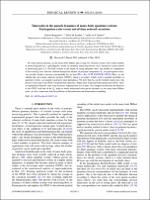Please use this identifier to cite or link to this item:
https://hdl.handle.net/20.500.12202/6448Full metadata record
| DC Field | Value | Language |
|---|---|---|
| dc.contributor.author | Santos, Lea F. | - |
| dc.contributor.author | Borgonovi, F. | - |
| dc.contributor.author | Izrailev, F.M. | - |
| dc.date.accessioned | 2020-11-19T19:52:54Z | - |
| dc.date.available | 2020-11-19T19:52:54Z | - |
| dc.date.issued | 2019-05-31 | - |
| dc.identifier.citation | Santos, Lea F., Fausto Borgonovi, Felix M Izrailev. (2019). Timescales in the quench dynamics of many-body quantum systems: Participation ratio versus out-of-time ordered correlator. Physical Review E 99(5): 052143 | en_US |
| dc.identifier.issn | Print: 1539-3755 Electronic: 1550-2376 | - |
| dc.identifier.uri | https://doi.org/10.1103/PhysRevE.99.052143 | en_US |
| dc.identifier.uri | https://hdl.handle.net/20.500.12202/6448 | - |
| dc.description | Research article, peer-reviewed. Open Access. | en_US |
| dc.description.abstract | We study quench dynamics in the many-body Hilbert space using two isolated systems with a finite number of interacting particles: a paradigmatic model of randomly interacting bosons and a dynamical (clean) model of interacting spins-1/2. For both systems in the region of strong quantum chaos, the number of components of the evolving wave function, defined through the number of principal components Npc (or participation ratio), was recently found to increase exponentially fast in time [Phys. Rev. E 99, 010101(R) (2019)]. Here, we ask whether the out-of-time ordered correlator (OTOC), which is nowadays widely used to quantify instability in quantum systems, can manifest analogous time dependence. We show that Npc can be formally expressed as the inverse of the sum of all OTOCs for projection operators. While none of the individual projection OTOCs show an exponential behavior, their sum decreases exponentially fast in time. The comparison between the behavior of the OTOC with that of the Npc helps us better understand wave packet dynamics in the many-body Hilbert space, in close connection with the problems of thermalization and information scrambling. | en_US |
| dc.description.sponsorship | F.B. acknowledges support from the I.S. INFNDynSys- Math. F.M.I. acknowledges financial support from CONACyT (Grant No. 286633). L.F.S. is supported by U.S. National Science Foundation (NSF) Grant No. DMR-1603418. | en_US |
| dc.language.iso | en_US | en_US |
| dc.publisher | American Physical Society | en_US |
| dc.relation.ispartofseries | Physical Review E;99(5) | - |
| dc.rights | Attribution-NonCommercial-NoDerivs 3.0 United States | * |
| dc.rights.uri | http://creativecommons.org/licenses/by-nc-nd/3.0/us/ | * |
| dc.subject | Nonequilibrium statistical mechanics | en_US |
| dc.subject | Statistical Physics | en_US |
| dc.title | Timescales in the quench dynamics of many-body quantum systems: Participation ratio versus out-of-time ordered correlator. | en_US |
| dc.type | Article | en_US |
| dc.contributor.orcid | 0000-0001-9400-2709 | |
| local.yu.facultypage | https://www.yu.edu/faculty/pages/santos-lea | |
| Appears in Collections: | Stern College for Women -- Faculty Publications | |
Files in This Item:
| File | Description | Size | Format | |
|---|---|---|---|---|
| Santos Timescales quench 2019 OA PhysRevE.99.052143.pdf | 557.97 kB | Adobe PDF |  View/Open |
This item is licensed under a Creative Commons License

